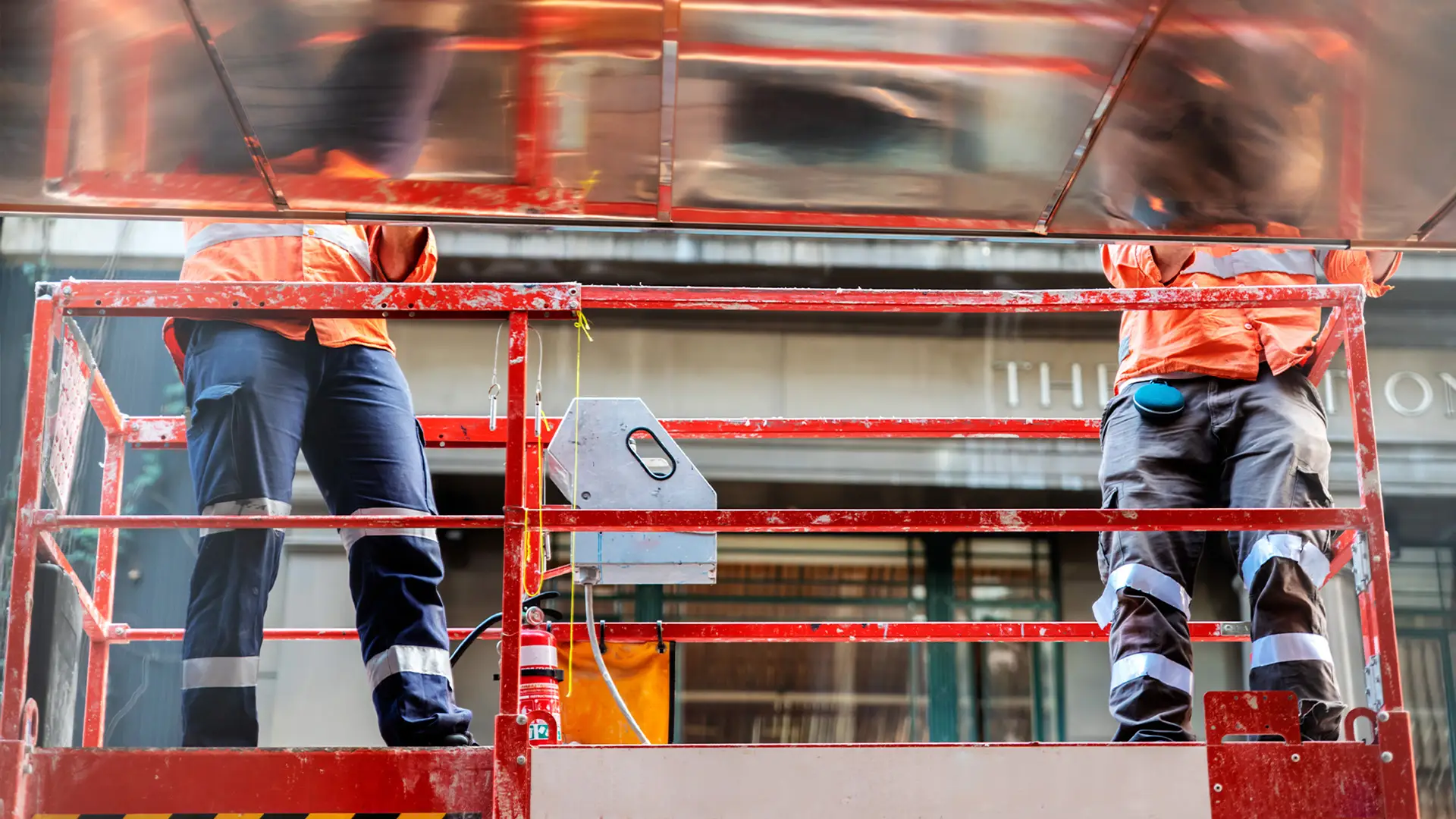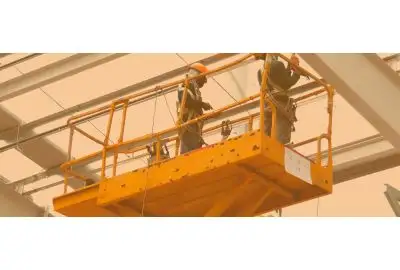Everyone loves scissor lifts. They are easy to operate, convenient to use, and versatile enough to be employed both indoors and outdoors. However, safety is always a top priority when working at heights. OSHA fall safety regulations for scissor lifts are straightforward, yet some people feel they don’t go far enough.
Many scissor lifts can elevate workers up to 60+ feet above the ground. A fall from such a height can result in severe injury, and from a 60-foot lift, it’s almost always fatal. While scissor lifts are generally considered safe, accidents can still happen.
Some argue that as long as operators are adequately trained and follow the correct procedures, accidents are nearly impossible. However, this overlooks the numerous risks present on any job site that could endanger workers at heights. We’ll delve deeper into these factors later.
Scissor Lift Safety Requirements
OSHA’s general fall protection requirements state that employers must provide fall protection for employees working at heights of four feet or more in general industries and six feet or more in the construction sector. Regarding scissor lift usage, OSHA mandates fall protection for workers on elevated platforms. This involves either using personal fall arrest systems or guardrails. Employers are also responsible for ensuring that scissor lift equipment is regularly inspected and properly maintained to remain operational.
In addition to these general and specific fall protection requirements, OSHA also demands that employers provide fall protection training to their employees. This training should cover the correct usage of fall protection equipment and the hazards associated with working at heights. Employers must maintain records of employee training, including the training date, participants’ names, and the type of training provided.
Types of Fall Protection for Scissor Lifts


Fall protection for scissor lifts is straightforward. As mentioned earlier, one of the following systems must be used: guardrails or fall arrest.
Guardrails
Most scissor lifts come equipped with guardrails. As long as the lift has guardrails around the entire platform perimeter and they meet OSHA specifications, you’re all set. That’s technically all the fall protection a worker needs. Even on specialty lifts that can reach heights of 100+ feet, the only fall protection requirement is a 35"-45" high guardrail to prevent falls.
This is where many in the industry disagree. OSHA standards represent the bare minimum safety measures, and everyone should aim higher than that. Many argue that at certain heights, workers should be required to wear personal fall arrest systems in addition to the guardrail system. Several companies have implemented policies requiring workers to use additional fall protection while on scissor lifts.
Fall Arrest
A personal fall arrest system (PFAS) includes a full-body harness, a lanyard/lifeline, and an anchor that work together to stop a fall and prevent the worker from hitting the ground. PFAS systems are highly effective in preventing injuries and fatalities in the event of a fall. Most scissor lifts come with anchor points. A worker would need to wear a full-body harness and connect it to the anchor point with a fall lanyard or an SRD. Learn more about SRDs and retractable devices.
Some tasks require removing guardrails on the scissor lift, particularly when a worker needs open access from one side. In these cases, OSHA mandates the use of a personal fall arrest system in addition to the remaining guardrails.
The reason there’s so much debate over OSHA’s relatively lenient fall protection standards for scissor lifts is due to numerous reported incidents of workers being ejected from the lift for various reasons. These accidents often result in serious injuries, and many end fatally. You can review the OSHA accident log on their website to see examples for yourself. For instance, in a 2021 OSHA case, a worker was moving a scissor lift and drove over an unmarked hole covered with plywood. The weight of the lift broke the plywood, tipping the lift and ejecting the worker, who fell to their death.
Best Practices for Scissor Lift Safety
One of the most important safety practices for scissor lifts is performing pre-use inspections. Before using a scissor lift, employers should inspect the equipment to ensure it’s in good working condition. This includes checking for damage, wear and tear, and ensuring that all safety features are functioning correctly. By conducting pre-use inspections, employers can guarantee that workers are using safe and reliable equipment.
Proper usage and operation of scissor lifts are also critical for safety. Employers should ensure that workers receive proper training on how to safely operate the equipment, including how to move around the platform and how to use fall protection equipment. Workers should also be trained to recognize and avoid hazards associated with working at heights.
We shouldn’t have to stress this, but regular maintenance is another key safety practice for scissor lifts. Employers should ensure that the equipment is serviced and maintained regularly to keep it in good condition. This includes inspecting and replacing worn or damaged parts. Regular maintenance can help prevent accidents by identifying and addressing potential issues before they become serious problems.
Employers should establish safety protocols and procedures for working with scissor lifts that exceed OSHA requirements. This includes having emergency procedures in place in case of an accident or incident, as well as providing appropriate signage and warning labels to remind workers of potential hazards. This ensures that workers are aware of the risks and know what actions to take in emergencies.
Safety Standards for Scissor Lifts
It’s crucial not only to understand OSHA requirements but also to familiarize yourself with industry standards. These standards are established by organizations like the American National Standards Institute (ANSI) and the International Standards Organization (ISO). These standards offer additional guidelines and recommendations for fall protection on scissor lifts beyond OSHA’s requirements.
ANSI Standard
One relevant industry standard for fall protection on scissor lifts is ANSI A92.20-2018, which covers the design, construction, testing, and maintenance of mobile elevating work platforms. This standard includes specific requirements for fall protection on scissor lifts, such as the requirement for guardrails when the platform is elevated and the need for personal fall arrest system anchors on the platform.
ISO Standard
Another relevant industry standard for fall protection on scissor lifts is ISO 12100-1:2010, which covers the safety of machinery. This standard includes requirements for the design and construction of scissor lifts to ensure they are safe to use. This includes specifications for fall protection systems and support structures.
How Can PowerPak Help?
Here at PowerPak, we aren’t in the business of selling scissor lifts. This topic is important to us because we are a safety company, and our mission is to ensure that workers and companies have quick access to the safety equipment they need.
Waiting two to three weeks for a safety harness or fall protection device will only lead to workers proceeding without the necessary equipment.
Read more about how to properly use safety harnesses.
PowerPak is built on four basic principles. We deliver as quickly as possible; shipment orders often go out the same day, and if you’re within our delivery range, your order will typically be delivered to you within a day by a PowerPak van or truck.
No backorders. If you see a product in our buyer’s guide, it’s in stock. We keep an inventory of all our products to eliminate any delays in your order.
Thirty-minute response time. It doesn’t matter how you contact us—whether by phone, email, or chat—we will respond to you as quickly as possible. No need to wait 24 hours just to place an order.
Lastly, we are leaders in the utility and infrastructure industry. We have over three decades of experience keeping workers safe.
Explore our offerings at PowerPak.net.
